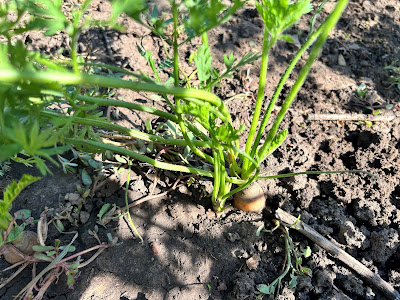The time of summer/fall harvest glut is upon us!
I live and garden at high elevation, so my days and nights are cooler than some other west slope communities and the front range. So, some of the crops I discuss in this blog, you may have already harvested in your area, or they may have gone to seed in the heat.
 |
| Various greens freshly harvested in July |
In my garden as well as most gardens in the state, greens are one of the first crops ready to harvest. You can harvest different ways: a few leaves at a time, starting with the bottom leaves that mature first or you can cut all the leaves off at the crown or you can pull up the entire plant.
 |
| This spinach was just cut. The crowns are left so the plants will re-grow. This is often called 'cut and come again. |
Carrots and other root crops like parsnips, beets, radishes and rutabagas are all harvested similarly. I like to water the day before I plan to harvest so the soil isn't rock hard. If the soil is too wet, it will be more difficult to remove soil that sticks to the roots. Grab the carrot top firmly in your hand right above the root top, wiggle and pull up slowly. Remove the carrots tops soon after harvest, to keep them from losing water and becoming soft.
 When you see the carrot top sticking out of the ground, your carrot is close to being ready to pull! |
 | ||||||||
If you leave your carrots in the ground too long, especially if it has been raining a lot, your carrot roots may split! When onions are ready to harvest, the tops will usually fall over.  Cure onions by letting the tops dry down in a well-ventilated, cool, shady place. I prefer to grow broccoli varieties that produce side shoots after you harvest the main head. This increases both your yield and extends the season of your broccoli harvest.
In many produce shows, the largest veggie contest is won by a zucchini! If you've grown zucchini, you know how fast they grow! Cucumbers, like summer squash, can outgrow their optimum eating stage very quickly. For best eating quality, harvest when the skin is tender and the seeds are still small.
|











No comments:
Post a Comment